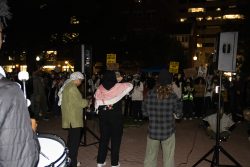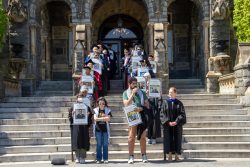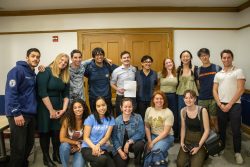ANC wants thirteen cameras placed throughout neighborhood
The Georgetown Advisory Neighborhood Commission has requested that 13 security cameras be placed at various locations in and around the West Georgetown and Burleith neighborhoods.
The camera request comes after the July 18 passage of an emergency bill requested by Mayor Anthony Williams and sponsored by councilwoman and mayor-hopeful Linda Cropp.
The bill allocates $2.3 million for the installation of 48 cameras in various sections of D.C. in addition to an $8 million request for police overtime.
Four temporary cameras have already been installed in particularly high-crime areas, while the rest are still on order.
The entire network should be in place by the end of September, according to Metropolitan Police Department Director of Corporate Communications Kevin Morrison.
The new cameras will record video in high-resolution, have the ability to pan and zoom and be remotely controlled from the station Morrison said.
Records are to be available for 10 days and exclusively used as evidence after a crime is committed.
“We are not having officers sit in front of monitors,” Morrison said.
Where the cameras will go, and whether they stay, remains to be seen. The bill states that although Police Chief Charles Ramsey has the final say, crime-levels and resident opinions are both important factors in deciding where the cameras will be placed.
The timetable must be quick, because the legislation expires Oct. 21 unless the Council votes to make the emergency measures permanent.
Though the crime rate in Georgetown is low compared to other sections of the city, Morrison said, the Georgetown ANC’s large request, 13 out of 48 cameras, reflects the general unease that has followed British student Alan Senitt’s fatal stabbing on Q St. on July 10.
As of August 18, acting commander of the 2nd District Sergeant Andy Solberg has recommended seven sights along Wisconsin and Connecticut avenues, including one at Wisconsin and M St., but it seems unlikely that Georgetown will receive it’s full request.
“Homicides in Georgetown are infrequent,” Morrison said. “I can almost guarantee that there is not a single community that will get 13 [cameras].”
Some members of the community who accept the limited police resources are willing to make a grab for as many cameras as they can and hope for the best.
“I think we’re only going to get two or three in the end,” ANC Commissioner Bill Skelsey said. “I think you aim high and see what you can get,” he added.
A neighborhood group called Georgetown Crime Stoppers is attempting to create a private network of cameras to make up the difference. Their goal is to have at least two cameras per block throughout Georgetown, president Kathy O’Hearn said.
The District already has 19 security cameras in strategic locations, mostly downtown, which are turned on to monitor major events like political rallies. These cameras are actively monitored by police and have flashing lights when activated.
Groups such as the American Civil Liberties Union and local youth groups have called into question the effectiveness of cameras in combating crime.
According to Thomas Nestel, a police inspector in Philadelphia who wrote his masters thesis on the use of police cameras, small camera networks “generally just displaced violent crime,” instead of preventing it.
Nestel said he did not believe that students would suffer increased police scrutiny.
“They can’t be bothered with using the cameras for nuisance violations,” he said.




